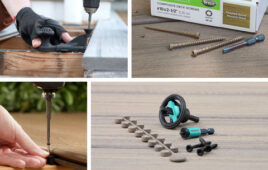Written by Jed Bothell, Vice President
Atlas UHV
Where many applications might allow for the use of mechanical bolting or an adhesive or sealant to bond two dissimilar metals, high-performance applications in aerospace, medical, cryogenic, and vacuum often require greater strength and longevity. Mechanical fasteners are ideal for several applications but are subject to cracking or corrosion, depending on the environment, and add weight to an assembly. Adhesives provide a solid bond at the beginning of use, but they typically degrade over time.

Bimetal components do not require bolting or the use of an adhesive. Advanced joining technologies enable engineers to reliably apply the ideal properties of one metal with those of another, offering an advantage in several industries, including the vacuum, cryogenic, and semiconductor sectors, as well as others.
Additionally, the process of joining certain materials, such as aluminum to other metals, is challenging. Its tenacious oxide surface protects it from rust-like oxidation, which is visible on iron and steel, preventing close metal-to-metal contact.
Fortunately, there are alternative methods for bonding dissimilar metals that ensure a solid bond.
The two most recognized methods are explosion bonding (or explosion welding) and diffusion bonding. Each one offers benefits and drawbacks, depending on the application. But both methods produce a molecular bond that out-performs mechanical bolting and adhesive bonding, which typically require upkeep and maintenance.
Explosion bonding or welding (EXW) is a solid-state process by which dissimilar metals can be joined together at an atomic level. Preparation for bonding requires that two plates lay flat against one another — a flyer plate on top of a base plate, separated by a small gap. An explosive charge is placed on the flyer plate and detonated from a point at the edge of the plates.
A controlled progressive ignition travels across the flyer plate much like ripples in a pond. The explosion accelerates the plates together with impact velocities of 1800 to 2200 m/sec. As a result, a high-energy surface plasma is formed between the plates, moving ahead of the collision point and stripping electrons from the two bonding surfaces.
The electron-hungry metals are then thrust together at extreme pressures, forming an electron-sharing bond.
Metals — such as copper, titanium, high-nickel alloys, and stainless steel — can easily be bonded through the EXW process. Typically, aluminum and stainless steel are incompatible and unable to bond directly, because of the formation of brittle intermetallic compounds.
However, technology is solving this challenge. One solution exploits the metallurgical compatibility from a multi-layered composition consisting of 316L stainless steel, copper, titanium, and 6061 T6 aluminum to provide a part with maximum hermeticity (or airtight), ductility, and an ability to cycle from cryogenic to high temperatures.
EXW is not always ideal. It depends on the final application. Depending on the bonding materials, explosive bonding typically requires a metal layer between the two primary metals, such as copper. This layer must be evaluated when producing a part because it also has characteristics that might affect the final application. For example, a copper substrate will add an electrically conductive layer to the end product.
Diffusion bonding is a process by which different metals are placed together at an extremely high pressure and heated to an elevated temperature for a specific duration. Bonding occurs in stages.

In the explosion bonding process, the EXW bond line separates the aluminum portion of a component from the stainless-steel part, as shown here.
First, the materials yield and creep in a way that the frictional force pushes waves of the now plastically deformed materials into a larger area of contact. Atoms that are in the contact area, then, diffuse and rearrange the grain boundaries of the two materials in such a way that it eliminates the original pores in the bonded area.
Finally, this diffusion dominates the area, forming a bond. It’s critical, however, that surface oxides are removed or displaced, which typically necessitates a vacuum environment.
It’s also important to note that diffusion bonding has machine limitations. This type of bonding depends on the strict control of bonding pressure, bonding temperature, the atmosphere, and the holding time. These conditions vary for bonding different materials. Aluminum stainless bonds are particularly challenging as a result of the formation of brittle intermetallic compounds, which can weaken the bond.
Additionally, thickness restrictions based on a machine’s size might create part size limitations. The joining of dissimilar metal parts requires a unique set of skills to properly machine the joined materials into a useable assembly. So, it’s important to work with reputable engineers or experts in the field.
A benefit of reliably bonded bimetallic joints is that these assemblies can be used to combine corrosion resistance, higher thermal conductivity, and several other properties not found in just one metal. With bimetallic joints, engineers can make a metallic composite material that enables them to attain the highest performance and maximum value.








Tell Us What You Think!